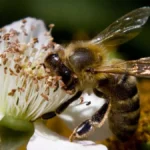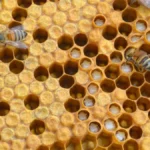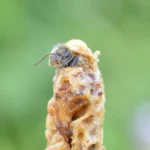Can worker bees lay eggs? Under certain extraordinary circumstances, worker bees can lay eggs. One special race of bees can even lay “fertilized eggs” which is a bit bizarre. We will go into this and explore the weird and wonderful world of laying workers.
The Orthodox Social Structure Of The Hive
The official version of the story is that the queen is the female reproductive in the hive. She lays fertilized eggs that turn into workers or queens. If the lays an unfertilized egg it develops into a drone.
If the queen dies, the workers will rear an emergency queen. If this emergency queen dies the bees become hopelessly queenless. Worker bees develop ovaries and lay unfertilized eggs. These drones are then the last chance of the hive to pass on its genes.
As with anything that is an orthodox system – there are some little critters out there just waiting to prove the system wrong and bring the whole system down on our heads.
Chromosomes and Bees
A worker bee is a diploid bee. What this means is that it has a set of chromosomes from the drone’s sperm cell that fused with the queen’s egg cell which also had a set of chromosomes. In other words, it has two sets of chromosomes and is termed diploid.
A drone bee on the other hand is derived from an unfertilized egg and hence only has a single set of chromosomes from the egg. A drone is therefore called a haploid.
If we look at the basic biology, this works along the lines that a queen bee can mate with a drone/drones and the resulting store of sperm she takes onboard allows her to fertilize eggs when she lays them. This means that a queen bee can choose – if she lays a fertilized egg it can be a worker or a queen. If she lays an unfertilized egg it is a drone. This system is called haplodiploidy.
Workers on the other hand are unable to mate, and as a consequence, should only ever be able to lay drone eggs if they lay eggs at all.
Laying Worker Bees
When a hive goes hopelessly queenless the worker bees can become laying workers. In this case, you can easily see that you have a laying worker beehive because the hive changes its nature. When you open the lid you hear a weird shiver buzz sound.
If you look at the bees in the hive, they are skittish and the hive looks very empty. The frames with brood will have a mess of eggs in both worker and drone cells. Basically, a worker bee is, by nature, a very poor queen bee. She is not long enough to lay eggs neatly in the center of a cell.
If you look in the brood area of a laying worker hive, you will find eggs scattered around the bottom of cells. Sometimes there can be as many as 10 eggs in a cell. You will have a mess of drones laid in worker cells and done cells. Some of these drones hatch and look like little abominations.
Laying Workers In Queenright Hives
Occasionally, in a very big beehive, the queen’s ability to suppress the development of worker ovaries allows some sneaky workers high up in the supers to develop ovaries. These workers will lay spotty drone brood in the supers. You know it is them doing this because the queen cannot get through the queen excluder.
If you start to see this, it is probably a sign that you either need to requeen or that you have too many supers on the hive. If you have too many bees in a hive, the social structure begins to break down. When workers start taking the future of the hive into their own hands and laying eggs, you have a breakdown of the overall order of the hive, and eventually, chaos ensues.
This is much like when a country becomes a failed state – when citizens overreach their rights, the natural order of a state is eroded and it fails. The same happens in a hive. There is an order, it may not be perfect, but the disorder is much worse.
Cape Honeybee Laying Workers
Apis mellifera capensis is just a more womanly bee than all other bees. Basically, these bees have a lot of queen pheromones. We will go into this in more detail shortly. In the event that a Cape honeybee hive loses its queen, the workers can actually lay fertilized eggs. This trait is called thelytoky. The important thing to stress about thelytoky is that no mating event has occurred to produce the offspring. The mother and “pseudo-clone” daughter are nearly genetically identical.

In the event that a Cape Honeybee hive loses its queen and goes hopelessly queenless, the workers will begin to lay eggs. These eggs will hatch and some will be female. Not all cape-laying workers lay worker eggs. Some, that lack the appropriate genes, lay drones eggs as per all other bee races.
Cape Laying Worker Hive
A cape-laying worker hive will also make the normal fizz hiss of a hopeless queenless hive when you open it. However, the fundamental difference here is that there is some reproduction of workers happening. I have had a few Cape Laying Worker hives in the past when in that region. If you are in the natural region of the Cape Bee, the bees requeen off a cape laying worker egg and recover. They do not go hopelessly queenless.
If the Cape Honeybee worker enters any other race of beehive, however, these workers will begin laying eggs. With time, the “Pseudoclone” offspring overwhelm the invaded hive in a form of social parasitism. The invaded hive collapses and the Clone Army of bees then move out and invade other hives in a rather Sci-Fi scenario.
The result of moving these bees outside their natural range is the catastrophic loss of other types of bees. This has happened in South Africa, with the Cape Honeybee decimating the so-called “Killer bee” – not through violence, but through being more genetically crafty. This risk remains and it must be reinforced that moving Cape Honeybees anywhere else on Earth is just a bad idea.
We hope this article has helped you understand a bit more about laying workers. Please share widely and let us avoid the rise of the clones outside their natural range. The last thing we need is another bee disaster.
Read more about: Types Of Bees
Worker Bee FAQs
Can worker bees lay eggs?
Yes, worker bees can lay eggs, but only under special circumstances. When a hive becomes queenless and workers activate their ovaries, they can lay unfertilized eggs, which will develop into drones (male bees).
What triggers a worker bee to lay eggs?
Worker bees lay eggs when the hive becomes “hopelessly queenless,” meaning there is no queen or replacement queen available. The absence of queen pheromones allows workers to develop their ovaries and begin laying eggs.
Can worker bees lay fertilized eggs?
In most honeybee species, worker bees can only lay unfertilized eggs, which turn into drones. However, the Cape honeybee (Apis mellifera capensis) can lay fertilized eggs through a process called thelytoky, producing female offspring without mating.
How can you identify a hive with laying workers?
A hive with laying workers usually has scattered eggs, often multiple eggs in a single cell. The brood pattern is chaotic, and the eggs are placed irregularly because worker bees are shorter and cannot lay eggs neatly like a queen.
Are laying workers a problem for the hive?
Yes, laying workers are typically a sign that the hive is in trouble. Without a queen to control the reproductive process, the colony will only produce drones, which cannot maintain the hive. The colony will eventually fail if a new queen is not introduced.
Can a queenright hive have laying workers?
Yes, in some cases, a large hive with too many bees can develop laying workers even when a queen is present. These workers typically lay drone eggs in the honey supers, and it is a sign that the hive’s social structure is breaking down.
What is the role of drones produced by laying workers?
Drones produced by laying workers serve the same function as drones produced by a queen: they are males whose only role is to mate with a queen from another hive. However, an overproduction of drones can weaken the colony since they do not contribute to foraging or hive maintenance.
How can a beekeeper prevent laying workers?
The best way to prevent laying workers is to ensure the hive remains queenright. Regular hive inspections to check for the presence of a healthy, laying queen can help prevent the hive from becoming queenless.
Can a hive recover from having laying workers?
It is challenging for a hive to recover once laying workers are established. Beekeepers may introduce a new queen, but workers may resist her. Another approach is to combine the laying worker hive with a healthy queenright hive to reestablish order.
What makes Cape honeybee laying workers unique?
Cape honeybee laying workers can produce female offspring through a process called thelytoky, making them unique among bees. These bees can reproduce without mating, which poses a significant risk to other bee populations through social parasitism.

Dr. Garth A. Cambray is a Canadian/South African entrepreneur and beekeeper with 28 years of experience in apiculture and specializes in adding value to honey. His Ph.D. research developed a new advanced continuous fermentation method for making mead that has resulted in a number of companies globally being able to access markets for mead. His company, Makana Meadery, exports honey mead to the USA where it is available to discerning connoisseurs. He has also developed technologies to commercially manufacture organic honey vinegar in Zambia for export globally. He holds a few patents globally in the ethanol industry and believes in technology and knowledge transfer for human development and environmental sustainability. One of his proudest achievements is the fact that the wind farm he started at one of his old apiary sites has essentially made his hometown carbon neutral.






